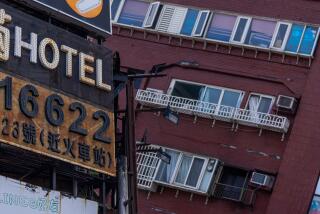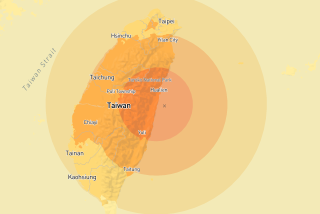Caribbean Islands Are Unprepared for Killer Tsunamis, Experts Warn
MAYAGUEZ, Puerto Rico â The Earth had barely stopped shaking when the sea peeled back, exposing hidden reefs and vast stretches of ocean bottom.
Moments later, an 18-foot wave slammed ashore, uprooting coconut palms, flattening huts and sending hundreds of people scrambling uphill for their lives.
One hundred sixteen people died in the 1918 Mayaguez earthquake, including at least 32 who drowned in the tsunami caused by the quake. Remnants of the wave reached Atlantic City, N.J., 1,365 miles away.
Little has been done since that disaster to prepare the Caribbean for tsunamis. Despite life-saving improvements in forecasting hurricanes, an earthquake is often the only warning that a killer sea wave is imminent.
âThe potential for a catastrophe is unimaginable,â George Maul, director of the Division of Marine and Environmental Systems at the Florida Institute of Technology, said during a recent regional workshop on tsunamis in Mayaguez. âWe need to get the attention of the heads of state and ring their bells and tell them, âThis is something you need to pay attention to.â â
Although more common and destructive in the Pacific Ocean, especially the Far East, tsunamis have killed more people in the Caribbean over the last 150 years (359) than in Hawaii (275), Alaska (121) or the U.S. West Coast (18), said James Lander of the University of Coloradoâs Cooperative Institute for Research in Environmental Sciences.
An estimated magnitude 7.3 earthquake in 1867 sent a 27-foot wave crashing into downtown Charlotte Amalie, St. Thomas, and the sister Virgin Island of St. Croix, killing at least 18. A 1946 quake and tsunami killed 100 people in the Dominican Republic.
The threat to lives and property has grown. At 30 million people, the Caribbeanâs population is 10 times greater than it was in 1867. Development on its prized--and vulnerable--island shores has proliferated. Charlotte Amalie now boasts waterfront hotels, shops and a busy cruise-ship pier.
âIt could affect our tourism, which is essential to our gross domestic product,â said John Denully, director of Antiguaâs National Office of Disaster Services. âWe have to ensure that our coasts are safe.â
Tsunamis can be generated by powerful quakes of magnitude 6 or higher, underwater landslides, volcanic eruptions and even by crashing asteroids.
Caribbean islands sit atop the Caribbean tectonic plate, a slab of land whose collision with the North American plate produces earthquakes and volcanoes. Moving eastward at about an inch a year, the Caribbean produces a magnitude 8 or greater earthquake every few hundred years.
Volcanoes have erupted in Montserrat, Martinique, Nevis, St. Vincent, Guadeloupe and Saba. A recent study suggests a dozen other âvolcanic centersâ exist in the western Caribbean, said William McCann, a Colorado-based consultant and former head of Puerto Ricoâs seismic network.
Potential tsunami threats include Kick âem Jenny, an undersea volcano just north of Grenada. Montserratâs active Soufriere Hills volcano could create a tsunami if it dumps a massive amount of earth into the sea at one time, said Allan Smith, a volcanologist at the University of Puerto Rico-Mayaguez.
One disaster official said he was impressed by a description of a 1958 tsunami caused by a landslide in Alaskaâs Lituya Bay. The wave rushed across the bay and more than 1,700 feet up a hill.
âThe highest point in Anguilla is only 200 feet,â said Sinclair Buchanan, disaster preparedness coordinator for the Caribbean English colony.
A regional warning center is needed, scientists agreed. Making it work is another matter.
Detecting tsunamis and issuing warnings is an inexact science. Response time at the U.S. government-funded Pacific Tsunami Warning Center in Hawaii is one hour. Thatâs too long to alert Caribbean islands close to the source of a tsunami, said the centerâs chief, Michael Blackford.
âA warning for a St. Croix tsunami might not help Puerto Rico. But it could take two hours to reach Venezuela, and you could help Venezuela,â Blackford said.
Few Caribbean seismic or meteorological agencies have the resources to contribute to an around-the-clock warning network. Deep-sea warning gauges cost hundreds of thousands of dollars to buy and maintain.
Some Caribbean officials said they would probably look to Washington to take a lead role. That might be difficult, given the relative infrequency of area tsunamis--about one every five years--and Washingtonâs budget-cutting mood.
âIf human lives are involved, then itâs worth it,â said Joseph Peterson, who represented Dutch St. Maarten at the conference.
More to Read
Sign up for Essential California
The most important California stories and recommendations in your inbox every morning.
You may occasionally receive promotional content from the Los Angeles Times.










